From their beginnings, BMWs have been best judged from the driver’s seat. The new BMW X7 demands a change of perspective: Many owners will base critiques of this long-awaited three-row “Sports Activity Vehicle” on its ability to comfortably accommodate their children, other people’s children, and all the crap a conspicuously-consuming family can pack aboard.
That’s not to say that the X7 doesn’t drive well, as I learned on the Phoenix-to-Las Vegas leg of BMW’s media tour, which sent a convoy of these luxury haulers from its Spartanburg, South Carolina factory to a finish line in Palm Springs, California. Ably spurred by a 335-horsepower, 3.0-liter turbocharged inline-six—or more-ably by a twin-turbo, 4.4-liter V8 with 462 horses—the X7 feels almost spookily quiet and cream-filled. Think a 7 Series sedan, only with room for six or seven adult passengers. And like its flagship-sedan cousin, this SUV range-topper is a showpiece for luxury and tech: If BMW makes it, you’ll find it here. Standard gear includes an air-spring suspension, the paired 12.3-inch digital displays known as Live Cockpit Professional, onboard wi-fi, six USB ports, and wireless phone charging. A CliffsNotes’ list of options would have to mention the three-row panoramic LED roof, active four-wheel steering, five-zone climate control, 22-inch alloy wheels, a 1,500-watt, 20-speaker Bowers & Wilkins audio system, rear-seat video entertainment, head-up display, Siri-like voice controls, LaserLight headlamps, and a factory-installed tow hitch.
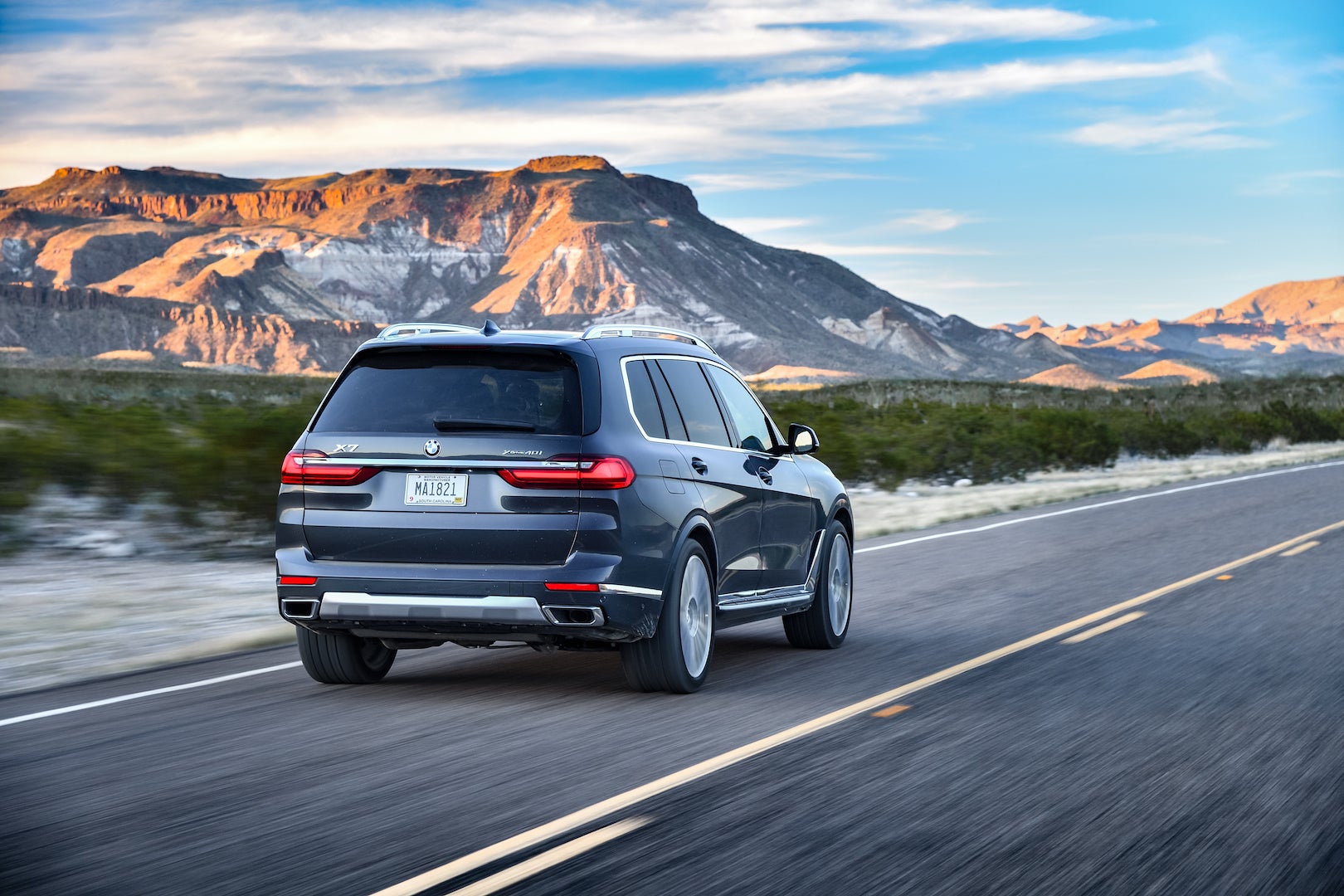
The X7’s bounteous size will surely bring some BMW trolls out from their caves—or rather, the cave-like rear seats of their vintage 3 Series. But if you’re expecting BMW to apologize, you’ve been living in your own cave. The brand’s sedan sales are tumbling, and it’s the expanding cast of X-Men—namely the X2, X3, X4, X5, X6, and now X7—that are putting up the big box-office grosses in America, China, the Middle East, and now, even Europe.
Over homemade pie at a charming small-town diner on old Route 66, Joerg Wunder, the X7’s proud project leader, argues that the X7’s shape makes it appear bigger than it is. Stretching 203.3 inches, the X7 is 10 inches longer, 3.5 inches taller, and 0.7 inches wider than its midsize X5 cousin. It's also 1.3 inches longer than its main rival, the Mercedes-Benz GLS-Class. But this Bimmer is still 3.3 inches shorter than a 7 Series, though nearly four inches wider. Since Europe’s roads and cities can accommodate a 7er, Herr Wunder says, the South Carolina-built X7 won’t seem out-of-bounds.
Wunder frankly acknowledges that, without an X7, BMW risked losing customers—some of whom simply rule out an SUV that doesn’t have three rows—to models like the Mercedes, which has been on sale for 12 years. BMW officially views the GLS as the X7’s only direct rival, but whatever: Many Americans will cross-shop the Audi Q7, even if the four-inch-longer BMW brings a more adult-worthy third-row, with four inches of bonus legroom and an inch more headroom. One might also consider the blingy Lincoln Navigator, or the bloaty Infiniti QX80 or Lexus LX 570. A Range Rover, for all its winning ways, only offers two rows of seats.
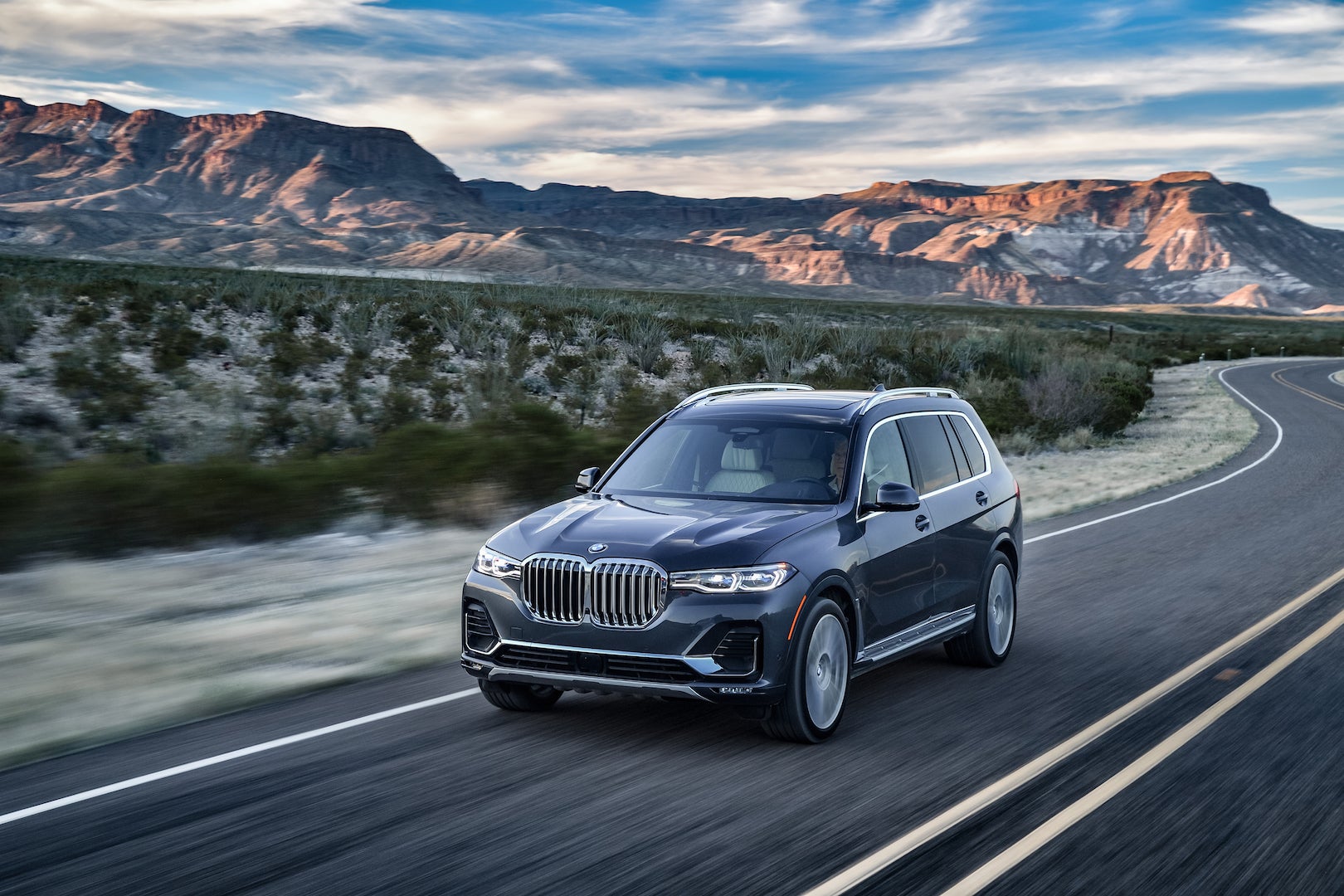
A friend that lives in Scottsdale thought the X7 looked like a large, sensible shoe. This Bavarian blucher appears tasteful and streamlined—a plus-size X5—but it doesn’t cut the dashing figure of a Range Rover. Like the low-key Mercedes, the X7 will commute and schlep without drawing many second glances, aside from envious moms and dads who want one of their own. To help snare attention, the X7 adopts the largest grille in BMW history, its twin kidneys appropriate for Bimmer's beefiest pie yet: The X7 xDrive 50i weighs 5,617 pounds in V8 trim, on par with Detroit’s half-ton crew cab pickups. Even the 40i model plops 5,370 pounds at the curb, about 440 more than a six-cylinder Audi Q7.
Remarkably, the 335-hp X7 40i can still steam to 60 mph in a BMW-tested 5.8 seconds, a testament to both BMW’s inline-six-making prowess and the seamless efficiency of its eight-speed, paddle-shifted ZF automatic transmission. The twin-turbo V8 model definitely felt stronger and more magisterial as we canyon-climbed toward the wondrous Hoover Dam and Lake Mead. And the V8’s big-money warble is appealing, especially when Sport mode amplifies the husky sound through a dual-flap exhaust. Officially, the 50i’s 5.2-second stomp to 60 mph is only six-tenths faster than the 40i model, but I expect the X7 V8 will actually do the trick in under five seconds. Both versions are limited to a 130-mph top speed. Honestly, unless you’re already used to a Range Rover budget, I found little reason to spend an extra $18,700 for the V8 version, priced from $93,595 versus $74,895 for the X7 40i. (Maybe it’s all relative: Mercedes demands $25,600 extra for its GLS550, at $96,745 compared to barely $71,145 for the GLS450.)
If the exterior can’t fully disguise its family-bus mission, the interior is like a tour bus for a superstar rock band, back when that kind of thing still existed. The space is vast and airy, with stunning polished wood, electroplated metal trim and optional diamond-cut glass for the shift lever and other controls. The Live Cockpit, already seen in action on models like the X5, ditches analog driver’s gauges for digital readouts—including a tachometer that winds counterclockwise, to some purists' dismay.
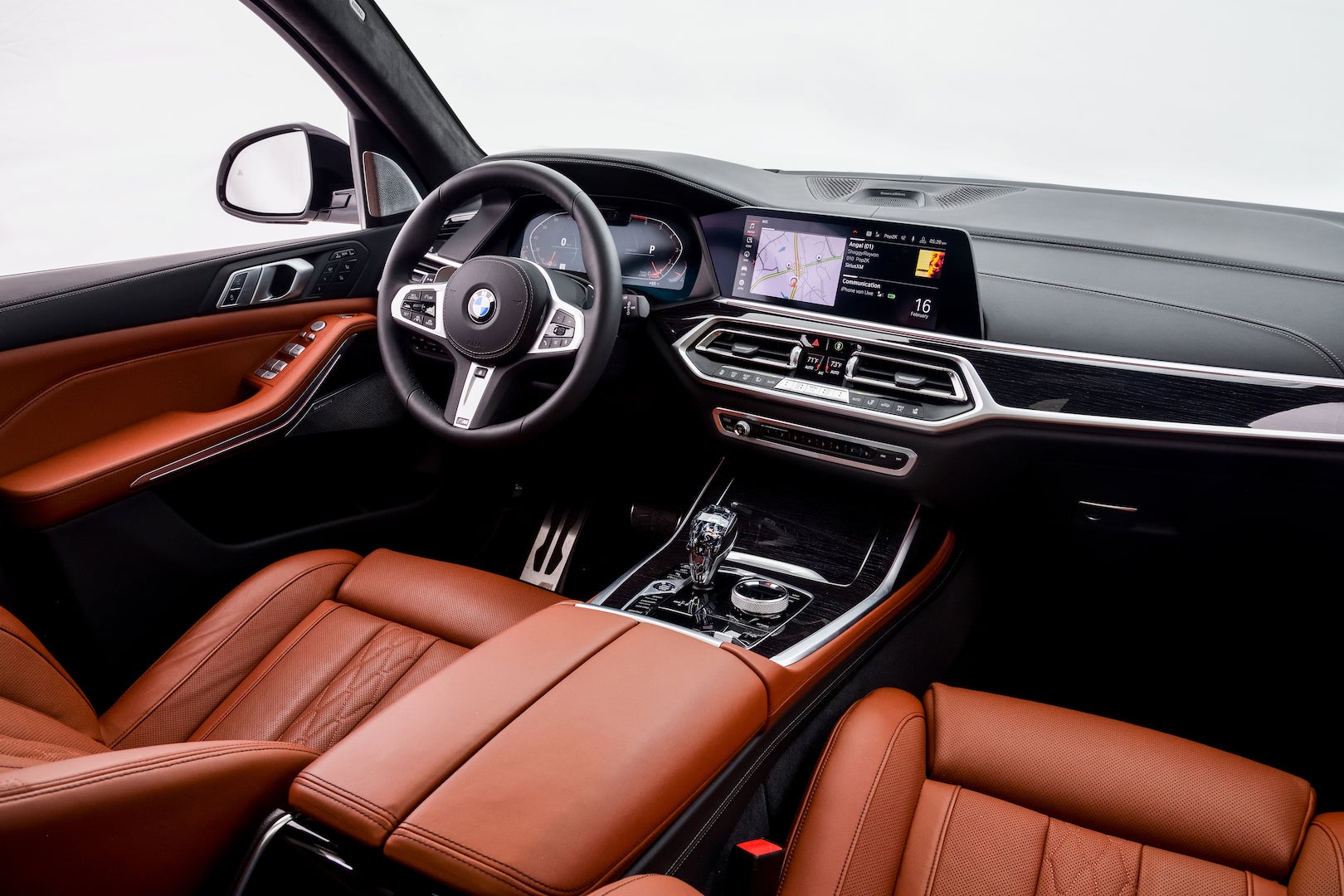
It’s rather amusing to see this much space and utility in a BMW, a company that not long ago could barely find room for a shallow console cubby. The sea change is underlined by massive front-row door pockets that could surely accept a 44-ounce Slurpee. (Is this a Chrysler minivan, or a BMW?) The X7 brings a standard, three-passenger bench for its center row; or for the first time in a BMW SUV, a set of captain’s chairs with Rover-style adjustable armrests. As Wunder noted, the six-passenger layout (a $600 option) brings a more deluxe vibe, and allows occupants to walk between second-row seats to reach the way-back. But the choice between those models may present the biggest conundrum to shoppers: Obviously, the seven-passenger version accommodates one more human, but its split-folding bench also brings a massive edge in overall utility, because the optional captain’s chairs don’t fold flat; you can slide skinnier gear between them and stow things on or around them, but that’s it.
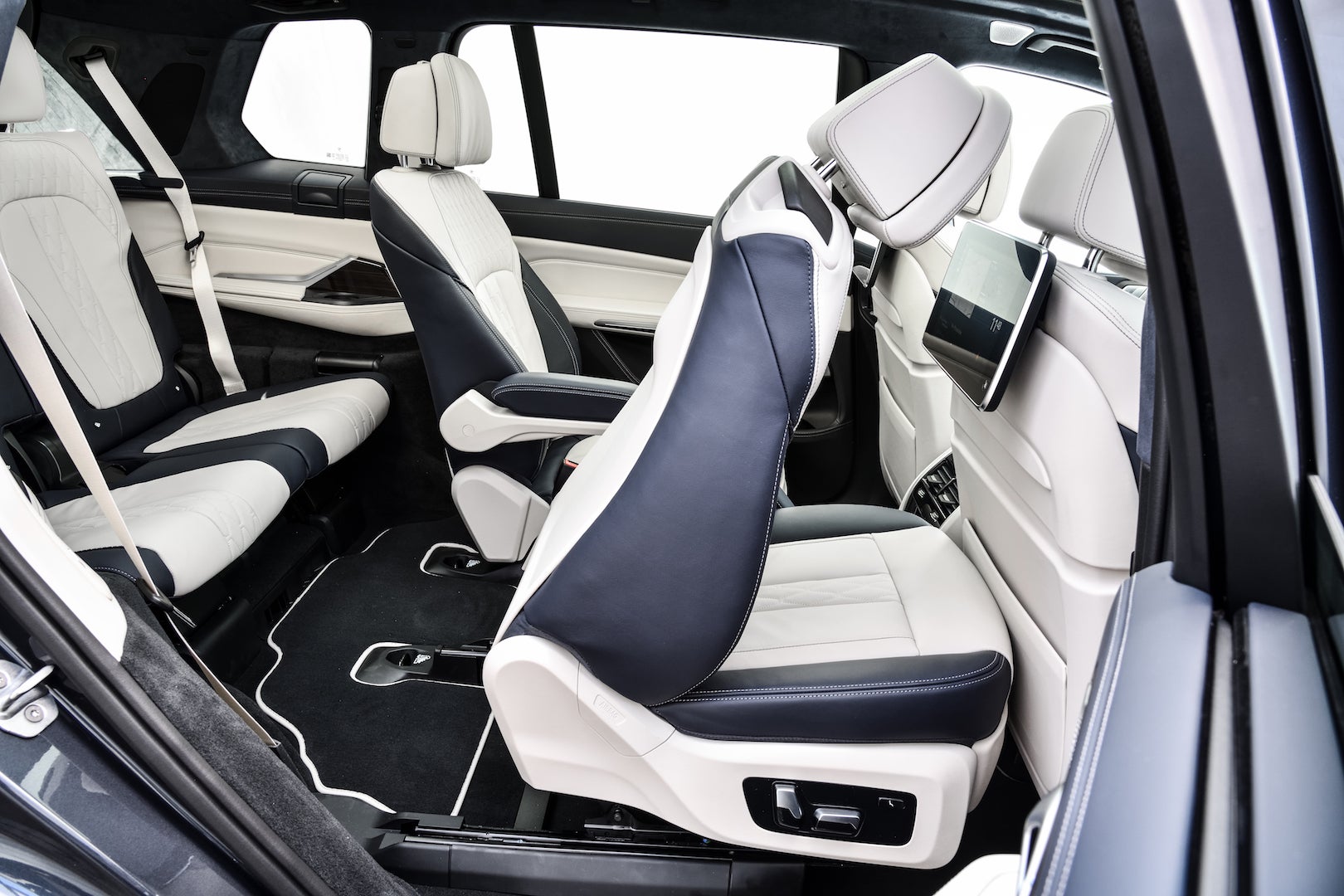
Both models bring 48.6 cubic feet of space behind the second row—a near-match for the big Benz, and 30 percent more than the Audi’s 37.5 cubes. But the seven-passenger X7 can expand total capacity to 90.6 cubic feet—again, dwarfing the Audi’s 71.6, and on par with the Benz or big-ass Cadillac Escalade. For the six-passenger X7, the Society of Automotive Engineers doesn’t officially credit it with any extra luggage space beyond the 48.6 cubes aft of the middle row. Again, shoppers should consider carefully, before they end up second-guessing their choice in second rows.

Seat adjustments for all three rows are electric, naturally. One-touch buttons mounted inside the driver’s-side second-row door fold and tilt the middle seats for way-back access, or fold or erect third-row seats. Other switches for the driver can control the front shotgun seat, or slide the middle-row chairs along 5.7 inches of fore/aft travel. That’s ideal for parental chauffeurs who want to load children without having to jump out and help...or talk to some obnoxiously-perfect soccer mom. And the third row is no penalty box, including its own climate controls, sunroof panel, and optional heated-and-cooled seats. I could spend hours in the BMW’s caboose with no complaints, thanks to ample room for riders over six feet tall.
A switch in the cargo hold lowers the BMW by 1.6 inches for easy loading through its two-piece tailgate. Dial up Sport mode or top 85 mph, and the BMW drops by half that distance to trim drag and boost handling. Two off-road heights bring a maximum 1.6 inches of lift, meaning the air suspension offers a total of 3.2 inches of height adjustment. There’s also an Off Road package, with a limited-slip rear diff, four terrain settings, and mild underbody armor.
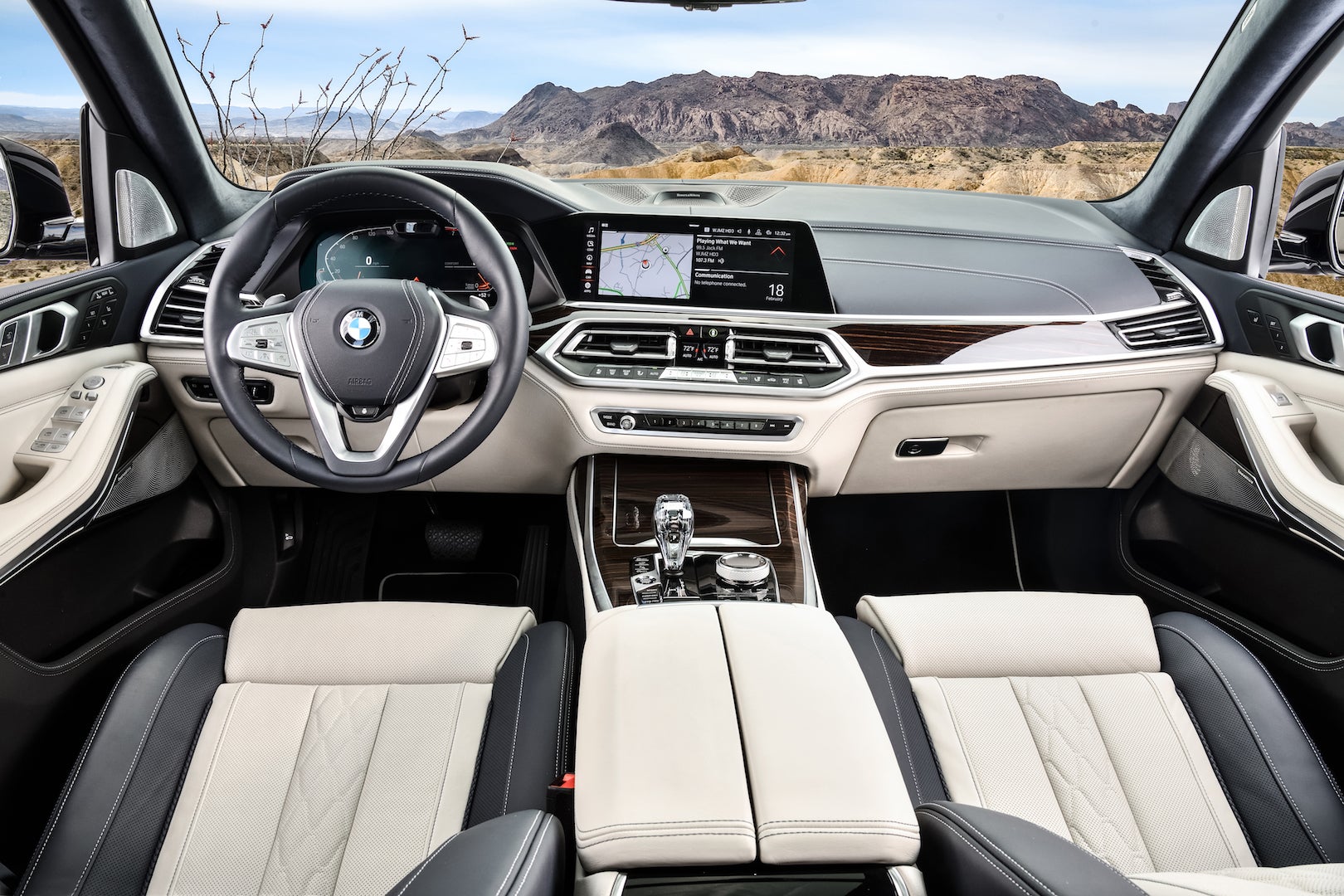
The cabin reaches apogee with a gorgeous, optional two-tone infusion of ivory and navy-blue Merino leather, including a blue leather dashboard and matching Alcantara headliner. More options, madame? Try massaging front seats, heated-and-cooled chairs in all three rows, hot-or-cold cupholders, warmers for armrests and center console, rear electric side-window shades and soft-close doors. The optional Panoramic Lounge roof uses LEDs to illuminate roughly 15,000 graphics in the glass to mimic a starlit sky.
Every X7 gets blind-spot detection, lane departure, cross-traffic and front/rear collision warnings, and auto-braking with pedestrian and cyclist detection. Standard on the 50i and otherwise optional, a driver-facing infrared camera in the instrument cluster monitors pilot awareness and recommends a break if it detects fatigue or inattention. On limited-access highways, at speeds of up to 37 mph in stop-and-go traffic, drivers can take their hands off the wheel for roughly 30-to-50 second intervals and let the X7 do its semi-autonomous thing. Make an evasive maneuver, and the X7 can nudge the vehicle more decisively into a clear, adjacent lane. The new Emergency Stop Assistant can assert control should the driver become incapacitated; pull the electric parking brake switch, and if road conditions allow, the BMW will automatically effect a controlled stop in the current lane, or move to the road edge or a hard shoulder; hazard lights are activated, and an emergency call is sent. And let's not forget the clever Back-Up Assistant, which I sampled on the all-new 3 Series, that lets the BMW automatically steer itself in reverse to mirror its last 50 feet of forward travel, no matter how tricky the path. It even works if you shut the X7 off and return to it later.
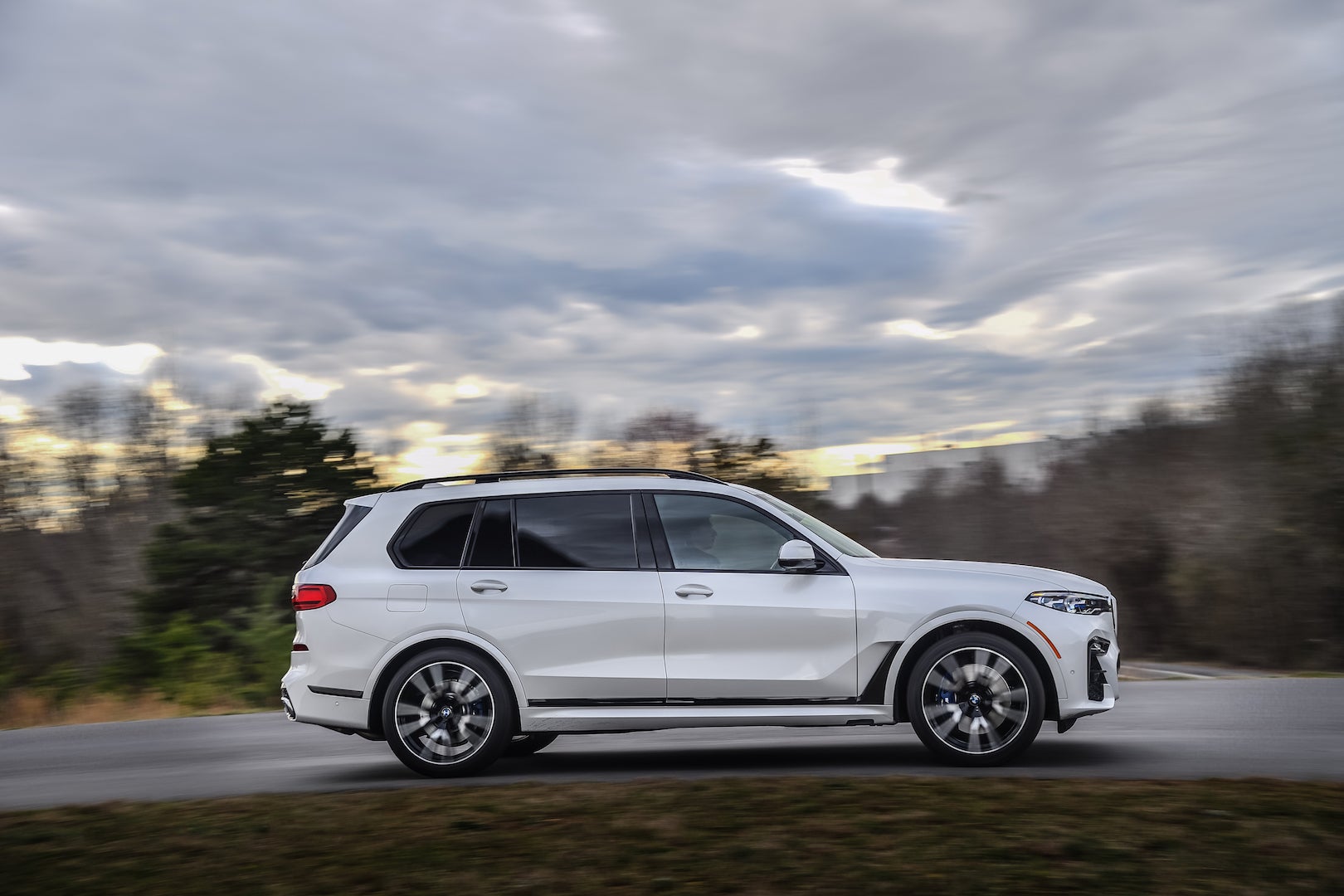
So what’s the X7 like to drive? Pretty damn good, considering its elephantine proportions. The body stays flat in fast corners, though the adjustable-ratio steering seems more interested in isolation than sporty exertion. One caveat: We spent nearly our entire day on easy-peasy highways en route to Las Vegas, so I’m not ready to pass final judgment on the BMW’s athleticism. Still, the X7 definitely felt sportier than a new Navigator or aging Benz GLS—no surprise Mercedes is readying an all-new version—and an easy match for a Q7 or Range Rover.
In steady-state operation, the xDrive AWD system divvies torque 50/50 to the front and rear axles, and can divert nearly 100 percent of power to either end when tires slip. Models I drove featured the Dynamic Handling package, which adds rear-wheel steering, active anti-roll bars, bigger brakes and, on V8 models only, the M Sport electronic rear differential, the latter helping the Bimmer lay down its beastly 479 pound-feet of torque when it’s exiting corners. That package adds a forward-facing camera that previews the road ahead, combines that real-time info with navigation data, and continuously adjusts the adaptive dampers and roll bars to boost cornering or smooth bumps.
Don't sweat the stoppers, either. Powerful by-wire brakes, sourced from Continental, keep this flying Dumbo on a short leash. Most drivers would never guess there’s no physical link between pedal and brakes; as on the new 3er, this is easily the most-natural by-wire braking system yet.

This much I can say: The X7 is one of the quietest, plushest SUVs I’ve ever driven, a dreamboat for family weekends or multi-state trips. Side mirrors seem small by Detroit-truck standards, but their petite shape helps reduce wind noise to uncanny lows. (“I’d like the mirrors to be even smaller,” Wunder said, but regulations won’t allow it.) At 90 mph, the X7 sounds and feels like it’s traveling 60; drivers won’t be fibbing when they tell the highway patrolman they had no idea how fast they were going. Even on 22-inch wheels, the air-sprung BMW buttered up the pavement, and should ride even better on standard 21s. And the 335-hp 40i model was easily up to the hefty task: On the big-sky Route 93 in Nevada, the six-cylinder X7 pulled to triple-digit speeds with zero strain. BMW's famously efficient inline-six also kicks fuel economy to 20/25 mpg in city and highway, a big jump over the V8 model's 15/21 mpg. On one highway stretch, I easily kept the 40i above 26 mpg, agreeable mileage for such a behemoth.
But the V8 X7 50i can suck up money as well as fuel. From its $93,595 base price, my X7 50i reached $120,945. Not that the six was a bargain; my base-price-of-$74,895 X7 40i rose as high as $100,995 on the final sticker. Note that these X7s were all stuffed with a half-dozen option packages, the $3,400 Bowers & Wilkins audio system, and $2,200 rear-seat entertainment setup. But come to think of it, what kind of monster would treat himself to this X7 and leave the kids bored in back?
Lawrence Ulrich,The Autance’s chief auto critic, is an award-winning auto journalist and former chief auto critic for The New York Times and Detroit Free Press. The Detroit native and Brooklyn gentrifier owns a troubled ’93 Mazda RX-7 R1, but may want to give it a good home.









